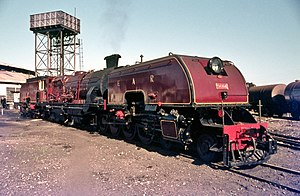East African Railways 56 class Dar es Salaam depot, Tanzania, in 1968Type and origin Power type Steam Builder Beyer, Peacock & Co. Serial number 7280–7285 Build date 1949 Total produced 6
Specifications Configuration: • Whyte 4-8-2+2-8-4 (Garratt ) • UIC (2′D1′)(1′D2′) h4 Gauge 1,000 mm (3 ft 3+3⁄8 in)Driver dia.48 in (1,219 mm) Adhesive weight 88 long tons (89 t) Loco weight 146.8 long tons (149.2 t) Fuel type Oil Fuel capacity 2,382 imp gal (10,830 L; 2,861 US gal) Water cap. 4,200 imp gal (19,000 L; 5,000 US gal) Firebox: • Grate area 48.8 sq ft (4.53 m) Boiler pressure 200 psi (1.38 MPa) Heating surface: • Firebox 164 sq ft (15.2 m) • Tubes 1,753 sq ft (162.9 m) • Total surface 2,287 sq ft (212.5 m) Superheater: • Type Inside • Heating area 370 sq ft (34 m) Cylinders 4 (Garratt) Cylinder size 16 in × 24 in (406 mm × 610 mm) Valve gear Walschaerts Loco brake Westinghouse type Train brakes Westinghouse type
Career Operators East African Railways (EAR)Class Number in class 6 Numbers EC6 class: 122–127 56 class: 5601–5606 First run 1949 Disposition All scrapped
The EAR 56 class was a class of 1,000 mm (3 ft 3+3⁄8 in) gauge 4-8-2+2-8-4 Garratt -type articulated steam locomotives built by Beyer, Peacock & Co. in Gorton , Manchester , England, in 1949. The six members of the class were ordered by the Kenya-Uganda Railway (KUR) immediately after World War II, and were a slightly modified version of the KUR's existing EC5 class .
By the time the new locomotives were built and entered service, the KUR had been succeeded by the East African Railways (EAR), which designated them for a very short time as its EC6 class, but then, as part of a comprehensive reclassification of all of its locomotives, redesignated them as its 56 class.
Class list
The builder's and fleet numbers of each member of the class were as follows:
Builder's
EC6 class
56 class
Notes
7280
122
5601
7281
123
5602
7282
124
5603
7283
125
5604
7284
126
5605
7285
127
5606
See also
References
Notes
Ramaer 1974 , pp. 65–66, 84, 86.
^ Ramaer 1974 , p. 66.
Durrant 1981 , pp. 189.
Bibliography
Durrant, A E (1981). Garratt Locomotives of the World David & Charles . ISBN 0-7153-7641-1 OCLC 9326294 . Durrant, A E; Lewis, C P; Jorgensen, A A (1981). Steam in Africa . London: Hamlyn . ISBN 978-0-600-34946-4 OCLC 9014344 . OL 15088099M . Wikidata Q111363476 . Patience, Kevin (1976), Steam in East Africa: a pictorial history of the railways in East Africa, 1893-1976 , Nairobi: Heinemann Educational Books (E.A.) Ltd, OCLC 3781370 , Wikidata Q111363477 Ramaer, Roel (1974). Steam Locomotives of the East African Railways . David & Charles Locomotive Studies. Newton Abbot, North Pomfret: David & Charles . ISBN 978-0-7153-6437-6 OCLC 832692810 . OL 5110018M . Wikidata Q111363478 . Ramaer, Roel (2009). Gari la Moshi: Steam Locomotives of the East African Railways . Malmö: Stenvalls. ISBN 978-91-7266-172-1 OCLC 502034710 . Wikidata Q111363479 . Staff writer (August 1958). ""56" Class Garratt Locomotive" (PDF). East African Railways and Harbours Magazine . 3 (10). East African Railways and Harbours : 344. Retrieved 9 December 2014. External links
EAR 56 class at Wikimedia Commons
Portals :
Categories :
EAR 56 class
Add topic
Text is available under the Creative Commons Attribution-ShareAlike License. Additional terms may apply.
**DISCLAIMER** We are not affiliated with Wikipedia, and Cloudflare.
The information presented on this site is for general informational purposes only and does not constitute medical advice.
You should always have a personal consultation with a healthcare professional before making changes to your diet, medication, or exercise routine.
AI helps with the correspondence in our chat.
We participate in an affiliate program. If you buy something through a link, we may earn a commission 💕
↑
 No. 5604 at Dar es Salaam depot, Tanzania, in 1968
No. 5604 at Dar es Salaam depot, Tanzania, in 1968![]() Media related to EAR 56 class at Wikimedia Commons
Media related to EAR 56 class at Wikimedia Commons